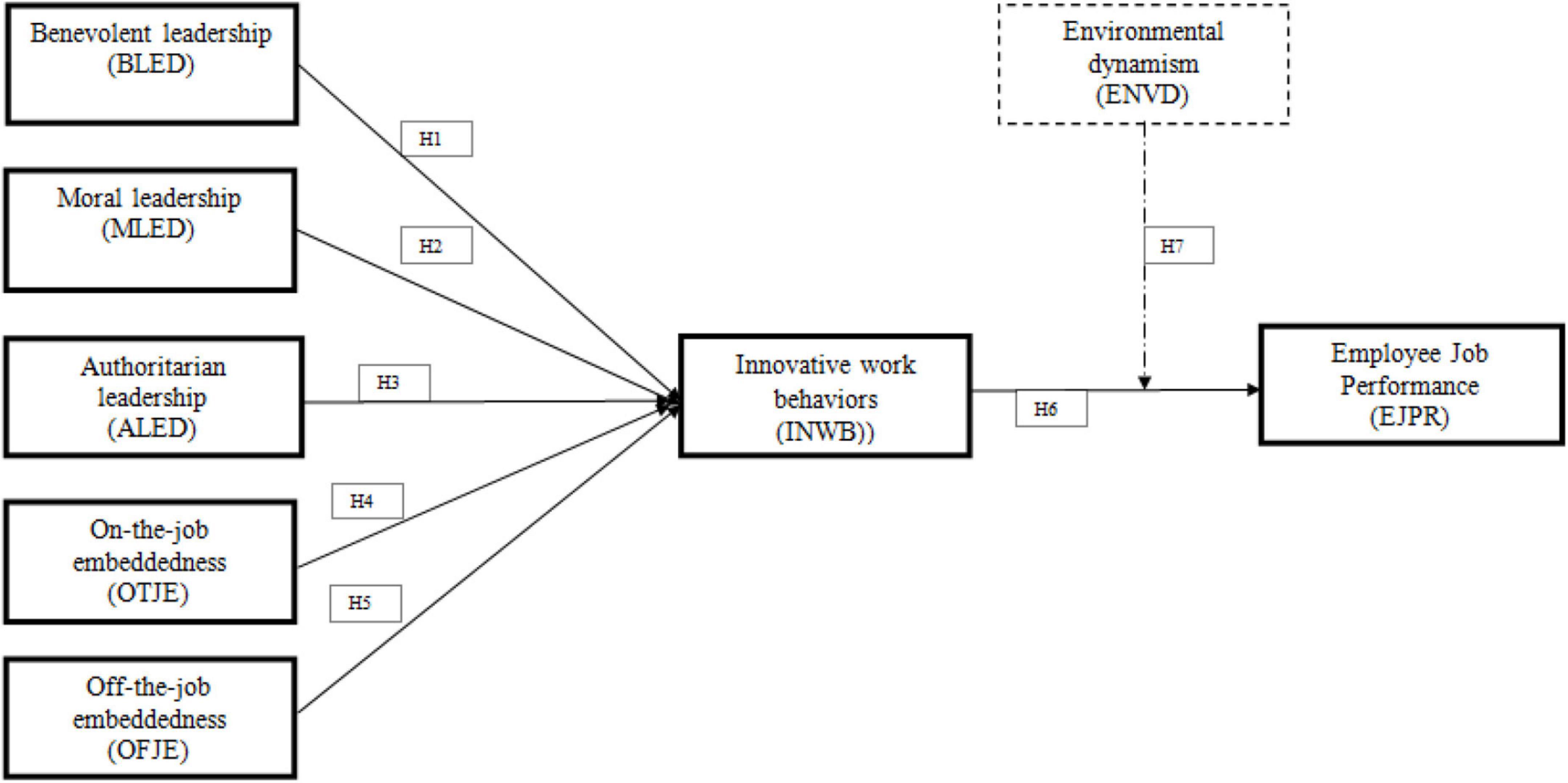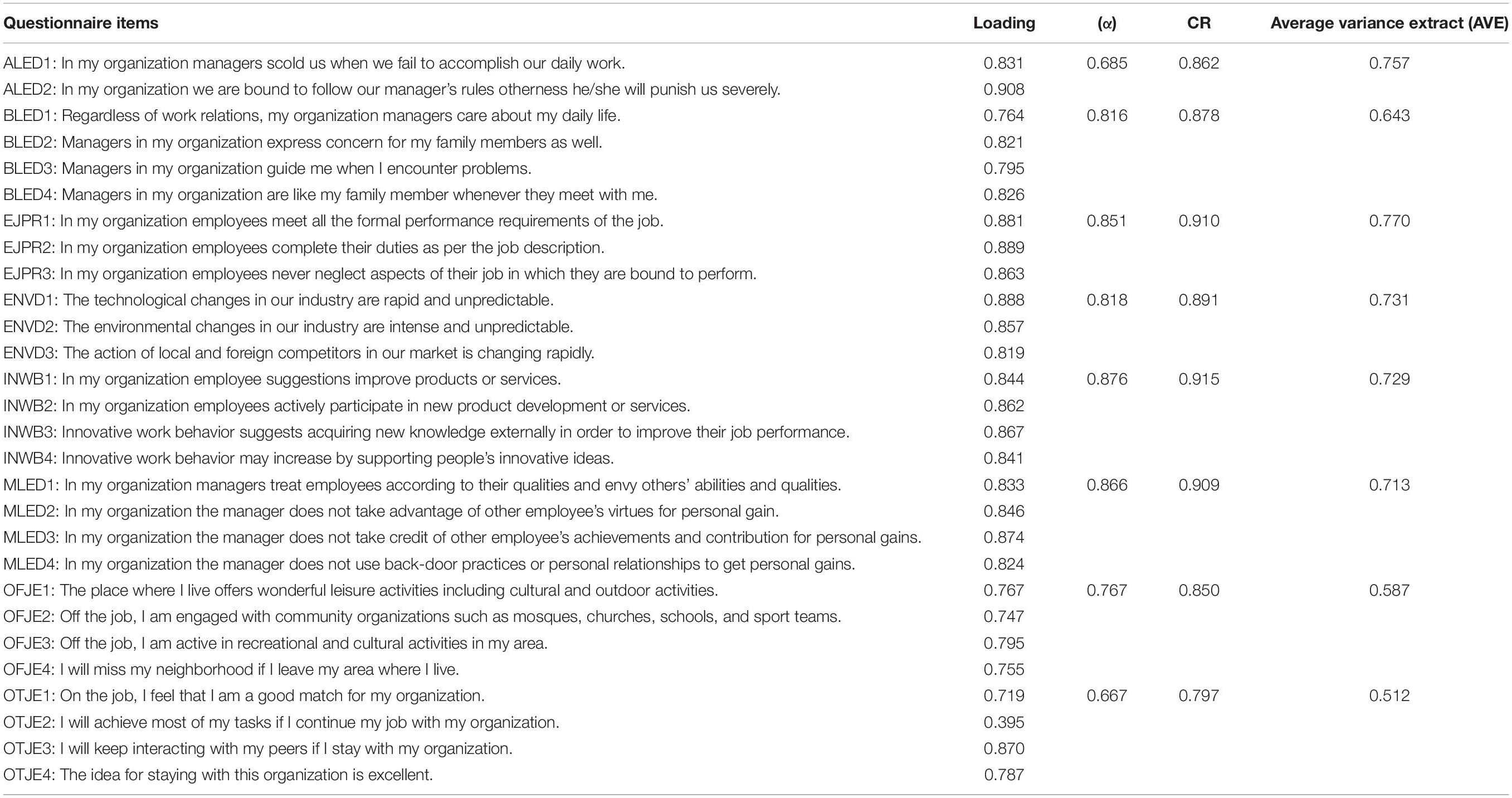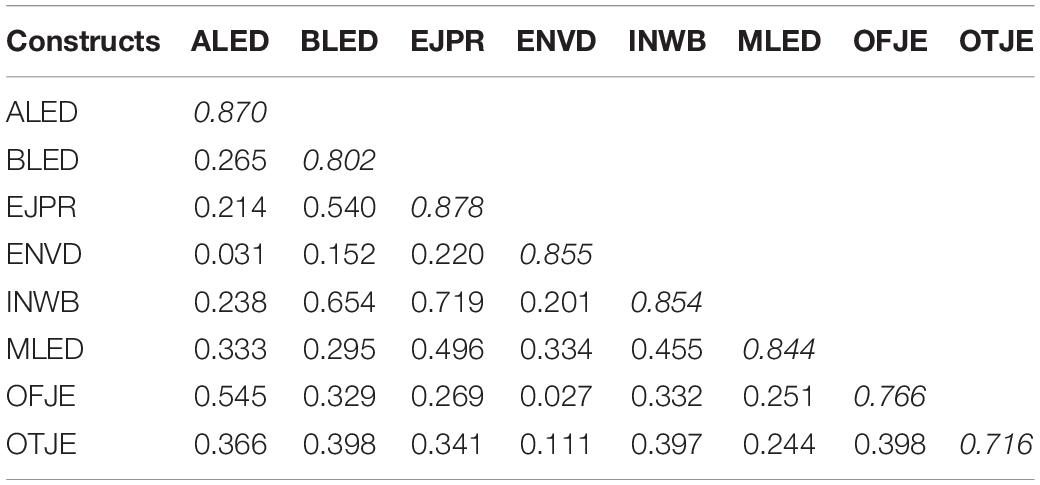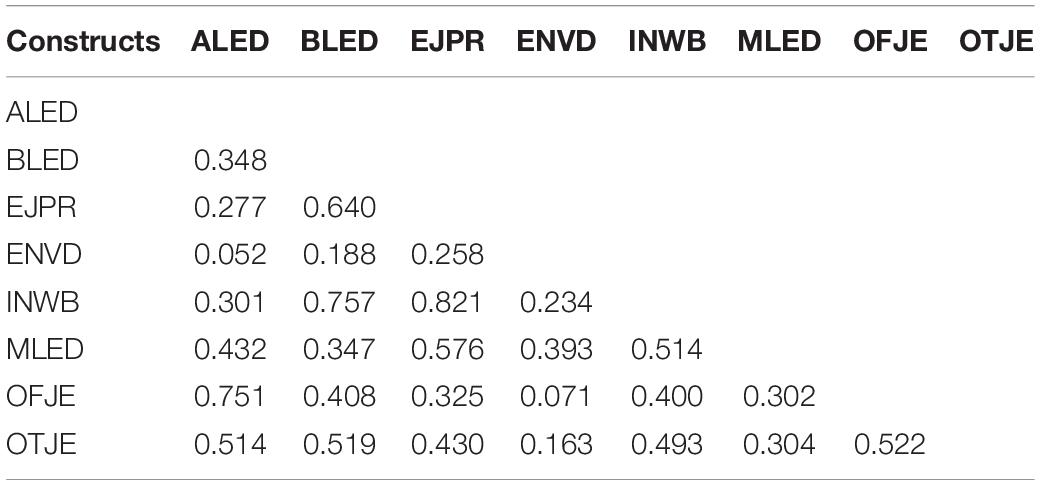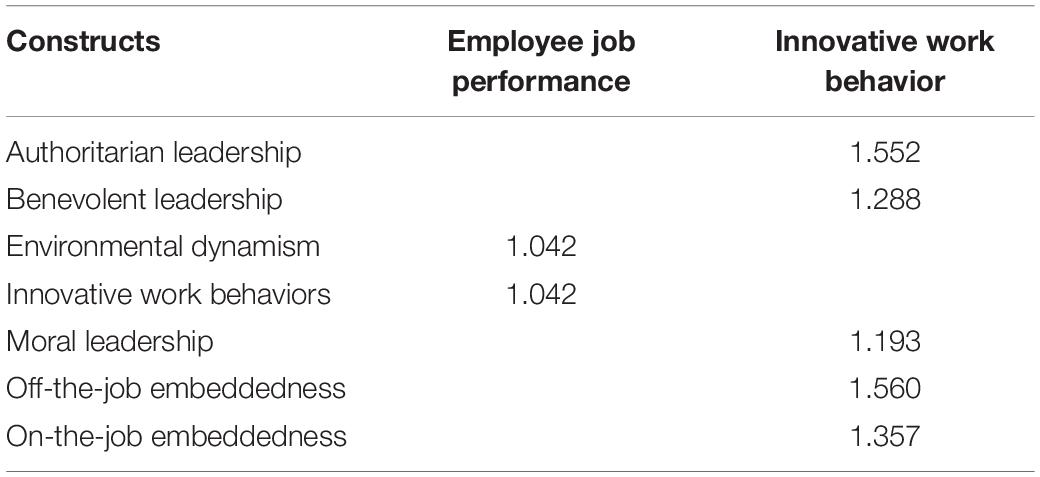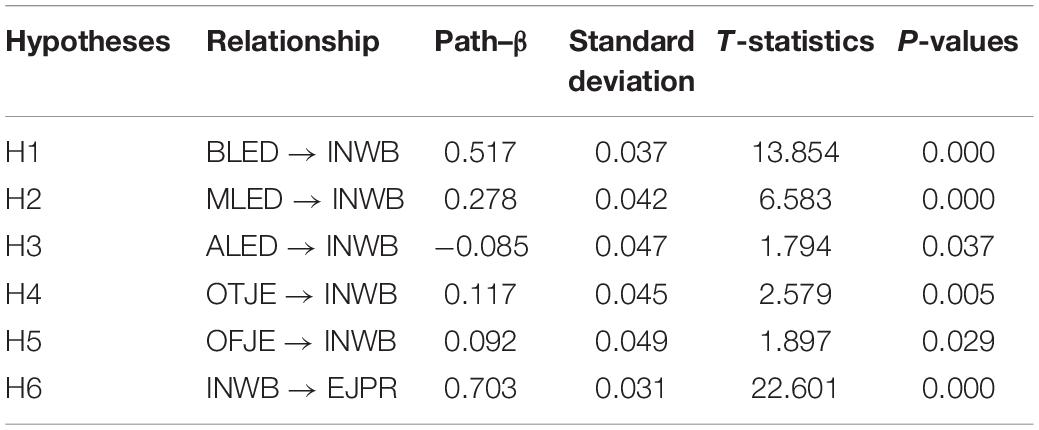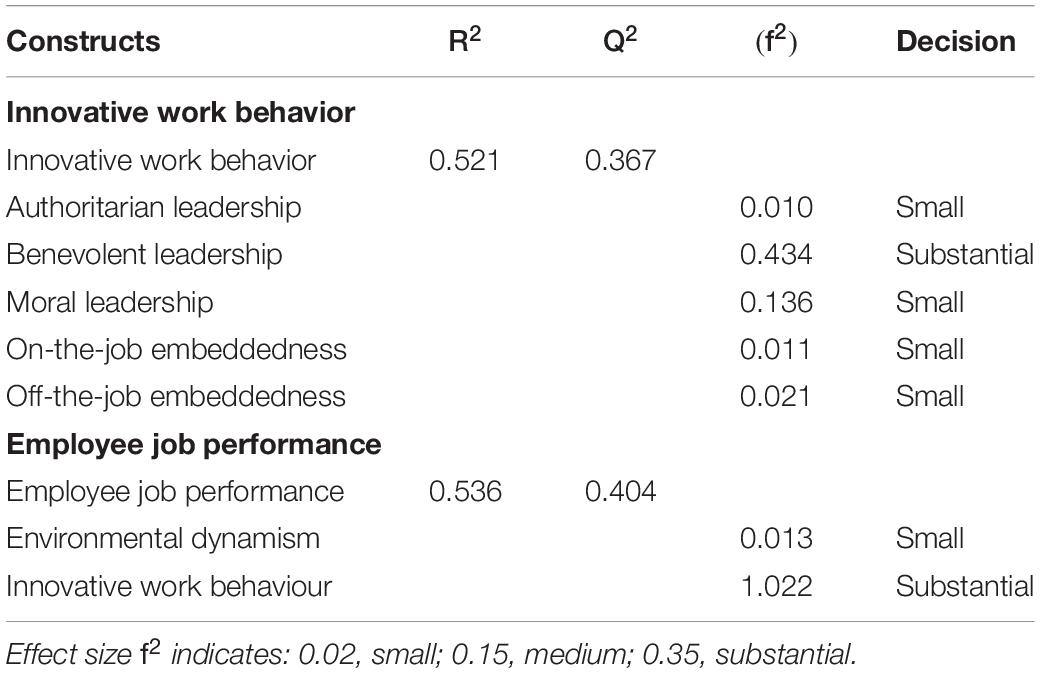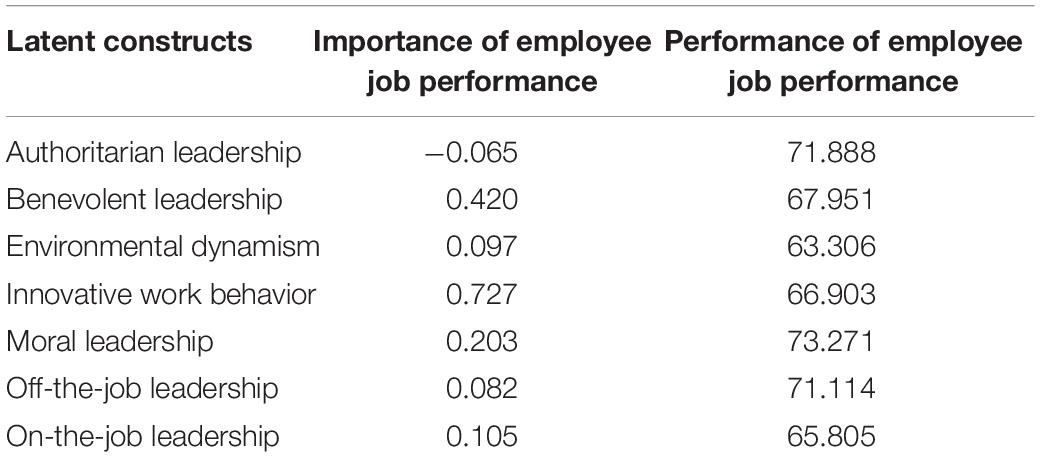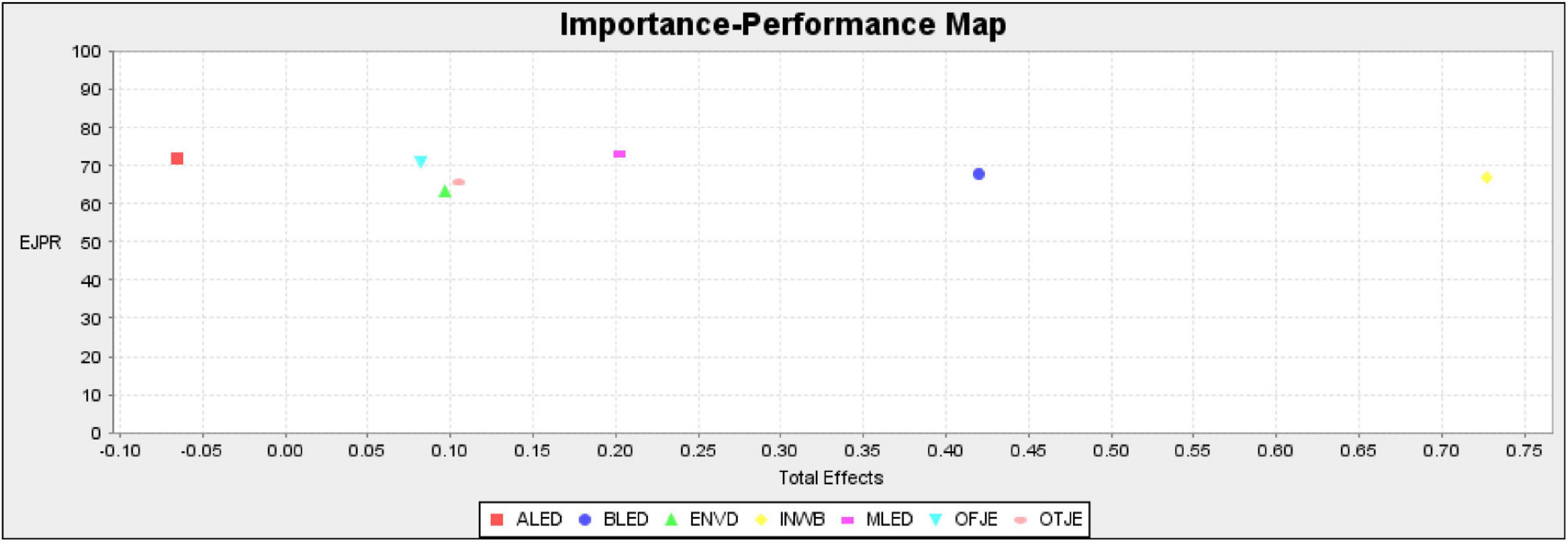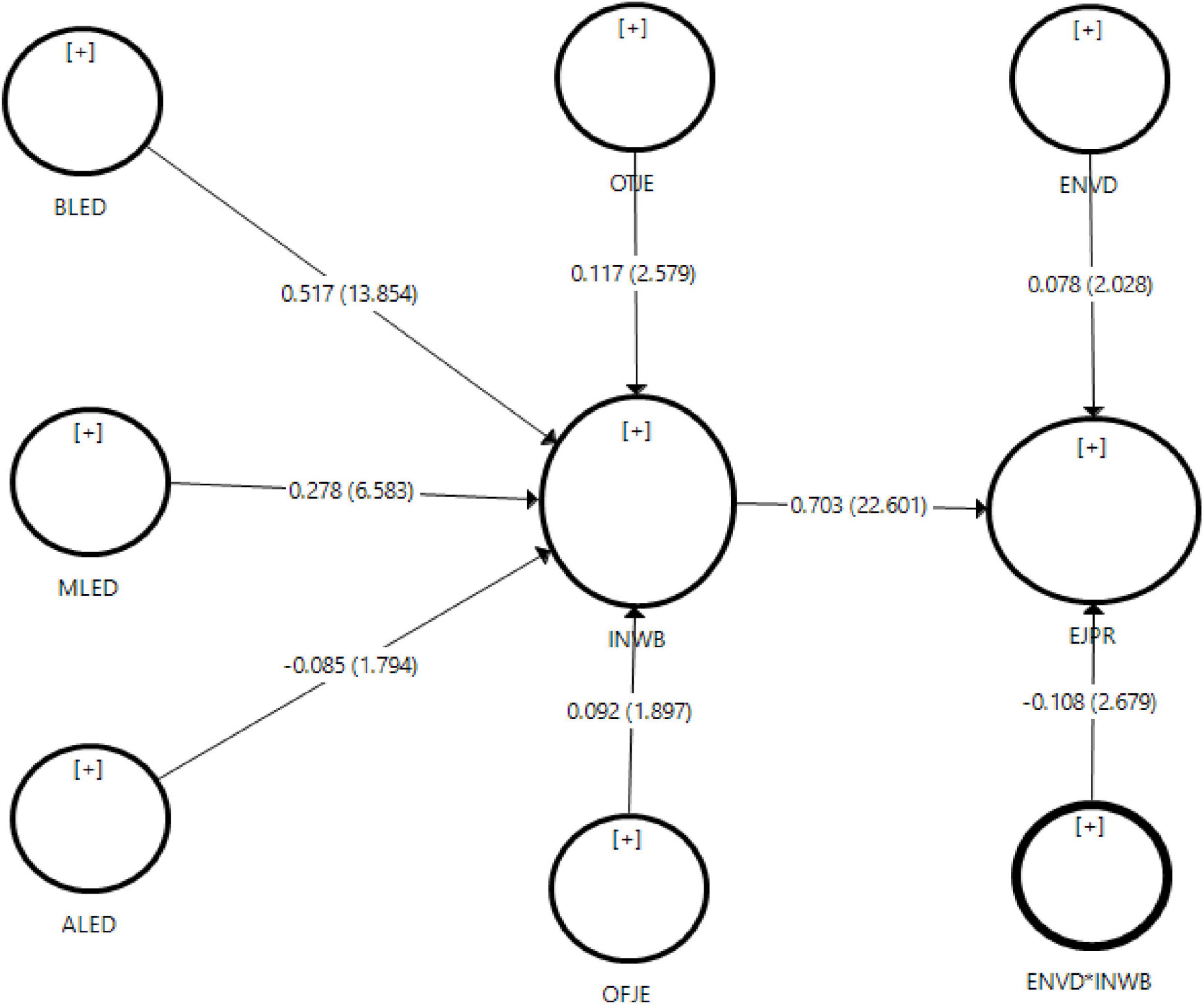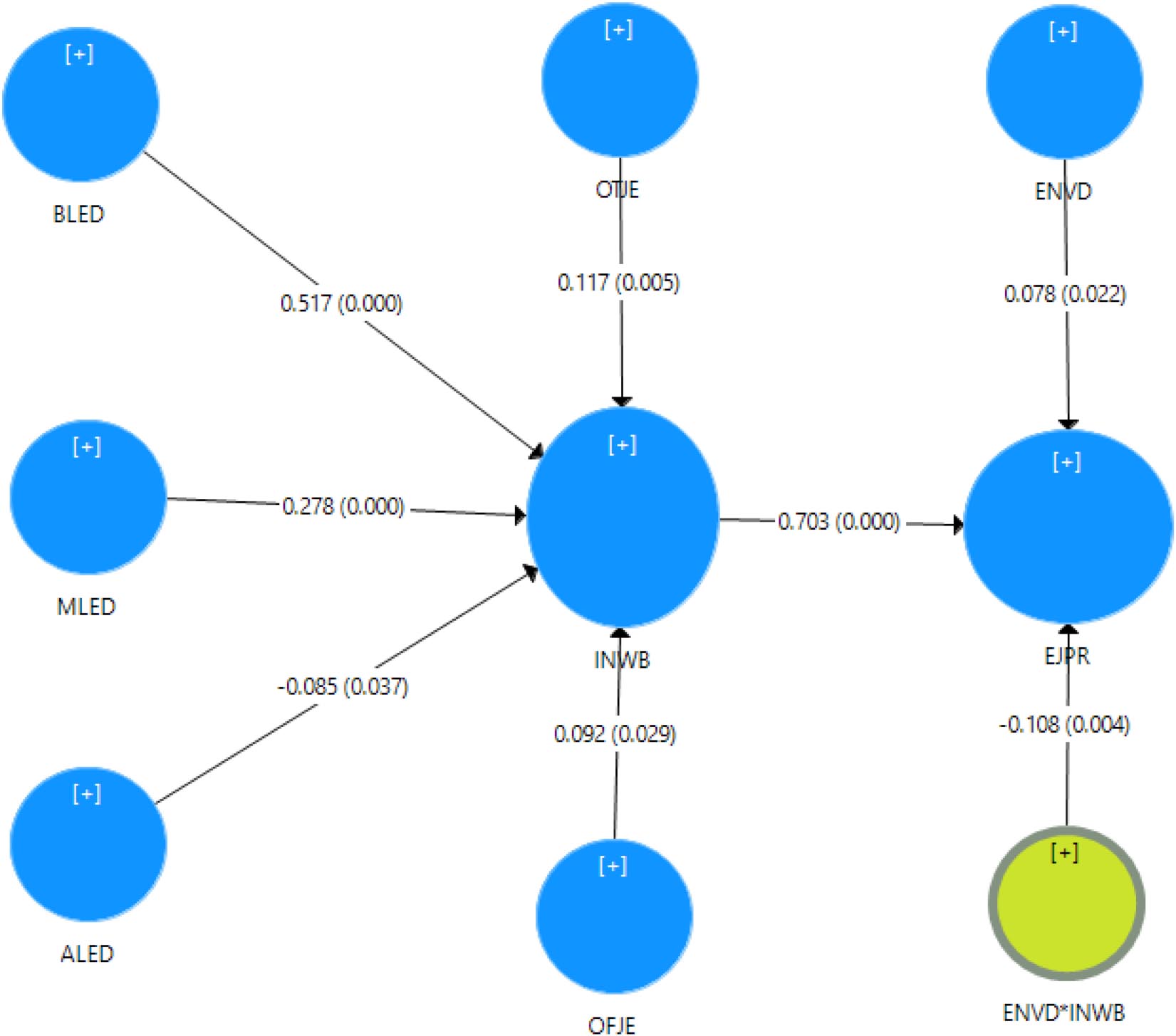- Department of Human Resources Management, University of Jeddah, Jeddah, Saudi Arabia
The current study strives to examine the determinants of employee innovative work behavior and job performance. Therefore, an integrated research model is developed with the help of paternalistic leadership style and job embeddedness theory to investigate employee behavior toward innovative work behavior. The research model is extended with the moderating effect of environmental dynamism between the relationship of innovative work behavior and employee job performance. Data were collected from 411 employees working in small medium enterprises. For inferential analysis, the structural equation modeling (SEM) technique is used. Results of the structural equation modeling revealed that altogether paternalistic leadership style and factors underpinning job embeddedness theory have explained 52.1% of the variance in employee innovate work behavior. The findings of this research suggest that managers and policy makers should focus on benevolent leadership, moral leadership, and on-the-job embeddedness to boost employee job performance and innovative work behavior.
Introduction
In today’s dynamic and complex environment, organizations need to incorporate innovative strategies to gain competitive advantages. It is noted that leadership style profoundly influences employee innovative work behavior (Shanker et al., 2017). Hou et al. (2019) postulated that leadership style had a significant impact on employee innovative work behavior. Therefore, examining the paternalistic leadership style toward employee innovative work behavior is the main point of discussion in this study. The paternalistic leadership style is different from conventional leadership and has been found in traditional Asian culture. The paternalistic leadership style works like a father role in a family who cares for his family, loves them, guides them, and supports them in each step of life (Hou et al., 2019). Authors like Erben and Güneşer (2008) asserted that implementing paternalistic leadership style in organizations increases employee commitment. Similarly, Chen et al. (2014) postulated that paternalistic leadership style boosts employee creativity and brings innovation to the workplace. Despite several useful outcomes, the impact of paternalistic leadership style in the context of employee innovative work behavior is less studied (Shanker et al., 2017; Hou et al., 2019). Authors like Khan and Mohiya (2020) asserted that little has been discussed about employee innovative behavior and its impact on small medium enterprises’ (SMEs) performance in Saudi Arabia. To fill this research gap, the current study investigates the core dimensions of paternalistic leadership style namely moral leadership, authoritarian leadership, and benevolent leadership, and examines how these factors influence employee innovative work behavior and job performance.
Organizations are striving to understand which factors motivate employees to not leave an organization and this phenomenon is also known as job embeddedness in human resource literature. Job embeddedness theory incorporates two types of embeddedness, namely on-the-job embeddedness and off-the-job embeddedness (Holtom et al., 2006). On-the-job embeddedness explains that employees individually assess their job internally using cognitive factors that arise in the workplace. Therefore, off-the-job embeddedness indicates that employees evaluate their job through external factors such as community, social, and psychological embeddedness (Jiang et al., 2012). Studies have shown the significant impact of job embeddedness on employee innovative work behavior and job performance (Jiang et al., 2012; Ng and Feldman, 2010, 2013). Thus, the current study examines job embeddedness with relation to innovative work behavior. This study extends the body of knowledge with the moderating role of environmental dynamism. Authors like Yang and Li (2011) revealed that environmental dynamism creates uncertainty in business operations and negatively influences employee job performance. Following the above arguments and supported by Holtom et al. (2006); Shanker et al. (2017), and Hou et al. (2019), this study develops an integrated research model that comprises factors underpinning paternalistic leadership, employee job embeddedness, and environmental dynamism to investigate employee innovative work behavior and job performance. The research model is exhibited in Figure 1.
Literature Review
Paternalistic Leadership
The paternalistic leadership style comprises three factors namely benevolent leadership, moral leadership, and authoritarianism leadership. Benevolent leadership is a situation wherein leaders create an environment of employee wellbeing and provide continuous care both in the workplace and outside of the workplace (Dedahanov et al., 2016; Sahoo and Sahoo, 2019). In the workplace, a benevolent leader allows employees to make mistakes and provide opportunities to learn and correct these mistakes (Shao, 2019). Therefore, outside of the workplace benevolent leaders treat them like a family and motivate them to overcome life challenges (Pellegrini et al., 2010; Yamin and Mahasneh, 2018). These kinds of deeds make employees more energetic, enthusiastic, and committed toward innovative work behavior (Fu et al., 2013; Tian and Zhai, 2019; Norouzinik et al., 2021). Earlier studies have confirmed that paternalistic leadership significantly influences employee creativity, organizational commitment, and organizational performance (Erben and Güneşer, 2008; Chen et al., 2014; Zhang et al., 2015; Dedahanov et al., 2016). Thus, the following hypothesis is proposed:
H1: Benevolent leadership has a positive influence on innovative work behavior.
The moral leadership style is the second important element of paternalistic leadership. This kind of leader entertains employees with high spiritual virtues, shows unselfish and self-disciplined behavior toward employees, respects rules, and refuses to abuse power (Cheng et al., 2004; Islam et al., 2021). Authors like Gu et al. (2018) stated that a leader with moral characteristics influences employee behavior in such a way that they might imitate leader behavior and wish to become like moral leaders. Earlier studies showed the significant impact of moral leadership in predicting employee innovative work behavior (Cheng et al., 2004; Zhang et al., 2015; Gu et al., 2018; Kuenzi et al., 2021). Therefore, as backed up by earlier studies conducted by Cheng et al. (2004); Erben and Güneşer (2008), Pellegrini et al. (2010); Chen et al. (2014), Zhang et al. (2015), and Gu et al. (2018), the following hypothesis is proposed:
H2: Moral leadership has a positive influence on innovative work behavior.
The third dimension of paternalistic leadership is identified as authoritarian leadership which indicates leaders’ rigidness toward subordinates in the workplace. The authoritarian leader has strong autocratic control over employees and in return requires utter obedience from employees (Gu et al., 2018). The authoritarian kind of leadership style creates a depressing culture in organizations and diminishes employee creativity (Zhang et al., 2015; Cortellazzo et al., 2019; Player et al., 2019). Organizations practicing an authoritarian leadership style are less productive due to the fact that employees are afraid of being scolded by authoritative leaders (Pellegrini et al., 2010). Similarly, employees show reluctance toward creativity and innovation and prefer to use existing human resource practices. For organizational success, it is important to mitigate the negative aspects of authoritarian leadership style (Cheng et al., 2004; Zhang et al., 2015; Gu et al., 2018). Literature in paternalistic leadership confirmed that authoritarian leadership style had a negative impact on employee innovative behavior (Cheng et al., 2004; Pellegrini et al., 2010; Zhang et al., 2015; Gu et al., 2018). Thus, the following hypothesis is outlined:
H3: Authoritarian leadership has a negative influence on innovative work behavior.
Job Embeddedness and Innovative Work Behavior
The concept of job embeddedness is extracted from voluntary employee turnover literature. In a human resource context, job embeddedness is seen as “the degree in which [an] employee explains a set of characteristics that [enables them] to continue [in a] job instead of leaving an organization” (Mitchell et al., 2001). Job embeddedness is further divided into two categories namely on-the-job embeddedness and off-the-job embeddedness. On-the-job embeddedness explains that employees individually assess their job internally using cognitive factors that arise in the workplace. According to Ng and Feldman (2013), employees with high on-the-job embeddedness have shown keenness in sharing new ideas. In addition to that, embedded employees spread innovation in an organization easily due to high on-the-job embeddedness (Ng and Feldman, 2010). On the other hand, off-the-job embeddedness indicates that employees evaluate their job through external factors such as community, social, and psychological embeddedness (Jiang et al., 2012; Morales-Sánchez and Pasamar, 2019). Employees with high off-the-job embeddedness have been shown to have a positive impact on employee job performance (Wheeler et al., 2012; Ng and Feldman, 2013). Earlier studies have shown that job embeddedness impacts employee innovative behavior (Feldman et al., 2012; Wheeler et al., 2012). Therefore, as backed up by existing work conducted by Mitchell et al. (2001); Jiang et al. (2012), Wheeler et al. (2012), and Ng and Feldman (2010, 2013), the following hypotheses are derived:
H4: On-the-job embeddedness has a positive influence on innovative work behavior.
H5: Off-the-job embeddedness has a positive influence on innovative work behavior.
H6: Innovative work behavior has a positive influence on employee job performance.
Environmental Dynamism
Organization success is connected with the intensity of the external environment. Environmental dynamism is defined as “the extent wherein organizations assess the rate of change and the degree of instability of the environment” (Yang and Li, 2011). In an external dynamic environment, organizations’ operation and performance might be affected due to shifting customer choices, advancement in technologies, and fluctuation in demand and supply (Jansen et al., 2009; Murcio and Scalzo, 2021). In other words, environmental dynamism creates great uncertainty in business operations and negatively influences employee job performance (Wang et al., 2013). Literature indicates that innovation may be risker in an organization that is facing environmental changes (Wang et al., 2013). Therefore, understanding the relationship between environmental dynamism and employee innovative work behavior is important for employee job performance (Jansen et al., 2009; Yang and Li, 2011). Earlier studies confirmed that changes in the environment had a negative impact on employee innovative work behavior and job performance (Jansen et al., 2009; Yang and Li, 2011). Therefore, the current study extends the body of knowledge in this context and outlines the moderating role of environmental dynamism between innovative work behavior and employee job performance which is in line with Wang et al. (2013). Therefore, the following hypothesis is proposed:
H7: Environmental dynamism negatively moderates the relationship between innovative work behavior and employee job performance.
Methodology
Respondents and Data Collection
For the research design, this study has adopted a positivist paradigm. The followers of positivist paradigm believe in fresh data collection to investigate the phenomenon. The population of this study includes employees working in small medium organizations in Saudi Arabia. For the sample size calculation, the researcher used prior-power analysis consistent with earlier studies (Rahi, 2017a; Rahi et al., 2020). Results indicate that 300 responses were enough to conduct factor analysis. A set of 569 questionnaires was distributed among employees using a convenience sampling approach. According to Rahi et al. (2019a), the convenience sampling approach is appropriate when the list of the respondents is not at hand. In addition to that, the convenience sampling approach helps researchers to engage with actual respondents (Rahi et al., 2019b). Out of 569 distributed questionnaires, 456 were returned with a response rate of 80%. Of these responses 45 were discarded due to inappropriate filling in, in line with Rahi and Abd. Ghani (2019b). Thus, a total of 411 valid responses were used for structural equation modeling (SEM).
Questionnaire Development
The theoretical model of this study is based on employee innovative work behavior and job performance with paternalistic leadership and job embeddedness theory. Therefore, a research questionnaire was developed comprising construct items. Construct items were adopted from previous literature and then adapted into the current research context. Construct items for innovative work behavior were adapted from De Jong and Den Hartog (2010). Employee job performance items were adapted from Janssen and Van Yperen (2004) and Khoreva and Wechtler (2018). Item scales for on-the-job embeddedness were adapted from Coetzer et al. (2018). Next to this, off-the-job embeddedness items were adopted from Felps et al. (2009) and then adapted into the innovative work behavior context. Construct items for environmental dynamism were adopted from Jaworski and Kohli (1993) and then adapted. The paternalistic leadership constructs which included authoritarian leadership, moral leadership, and benevolent leadership were adopted from Erben and Güneşer (2008), and then adapted into the current research context. All construct items were measured with a Likert point scale ranging from 1 for strongly disagree to 7 for strongly agree.
Testing Common Method Variance Issue
For the research design, this study is quantitative in nature and investigates the phenomenon using fresh data. According to Samar and Mazuri (2019a), a study that collects data using a single source may be affected by common method variance bias. Therefore, testing common method variance bias before the structural equation model is important (Bader and Mohammad, 2019; Samar and Mazuri, 2019b; Yamin and Sweiss, 2020). In this study, the common method bias was tested with Harman’s single factor analysis which suggests that the variance explained by a single factor should not be greater than 40% (Podsakoff et al., 2003; Rahi and Abd. Ghani, 2019a). Results revealed that the variance explained by a single factor was only 14% which showed that common method variance (CMV) was not likely an issue in this research.
Data Analysis and Results
The research model was tested with the latest statistical approach namely structural equation modeling (Hair et al., 2016). For structural equation modeling, the researcher used a two-step approach which included a measurement model and a structural model (Rahi, 2017b). The measurement model assesses construct reliability and validity, therefore the structural model tests the causal relationship between exogenous and endogenous variables. The details of the measurement model and structural model are given in the following sections.
Measurement Model
The measurement model confirms convergent validity and discriminant validity of the constructs (Yamin, 2019). The convergent validity of the construct is achieved with Cronbach’s alpha, composite reliability, average variance extracted, and factor loadings of the constructs (Yamin, 2020a). In order to achieve construct reliability, the values of Cronbach’s alpha and composite reliability should be greater than 0.70, which indicates satisfactory reliability of the construct. Construct reliability is also assessed with average variance extract (AVE) following the criterion that the values of AVE should be higher than 0.50, meaning the construct is reliable. Finally, factor loading of the construct is tested following the criterion that loading should be greater than 0.60 as suggested by Rahi and Abd. Ghani (2019c). Results indicated that all the values of composite reliability, Cronbach’s alpha, average variance extracted, and factor loadings were adequate, hence confirming reliability of the constructs. Table 1 shows the results of the measurement model.
The convergent validity of the research model was achieved with factor loadings, average variance extracted, Cronbach’s alpha, and composite reliability. Therefore, the discriminant validity of the research constructs was examined with Fornell and Larcker criterion (Fornell and Larcker, 1981). According to Rahi and Abd. Ghani (2018), discriminant validity confirms that the construct is dissimilar and measures different concepts. In order to achieve discriminant validity, the criterion is that the values of AVE should be greater than the correlation of the corresponding construct indicating that the construct is discriminant (Fornell and Larcker, 1981; Yamin and Sweiss, 2020; Yamin, 2020b). Table 2 depicts the results of discriminant validity herein the values of average variance extracted were greater than the correlation of the corresponding constructs. These findings confirmed the discriminant validity of the constructs.
The discriminant validity was tested by applying the heterotrait-monotrait ratio (HTMT) method (Rahi et al., 2018; Yamin and Alyoubi, 2020). This method suggests that the values of HTMT analysis should not be greater than 0.85 indicating adequate discriminant validity of the constructs (Gold and Arvind Malhotra, 2001; Kline, 2011; Samar et al., 2017; Yamin and Mahasneh, 2018). The results of HTMT analysis indicated that all HTMT values were less than 0.85 confirming that the construct was discriminant and measured distinct concepts. The results of HTMT analysis can be seen in Table 3.
Structural Model
The structural model assessment included calculation of the coefficient of determination R2, lateral multicollinearity, path coefficients, t-statistics, and significance level of the hypothesis. According to Hair et al. (2016), the measurement model confirms vertical multicollinearity, therefore it is important to check lateral multicollinearity of the construct using variance inflation factor (VIF) analysis. In order to achieve lateral collinearity, the criterion is that the values of the VIF should not be higher than 3.3 (Hair et al., 2016; Mohammad Ali, 2018). Results of the structural model revealed that the values of variance inflation factor were less than 3.3 when comparing endogenous variable VIF values with exogenous variables. These findings confirmed that lateral multicollinearity was not likely an issue in this study and in line with Yamin and Sweiss (2020). The results of the VIF analysis can be seen in Table 4.
Hypothesis Testing
The causal relationship between hypotheses was tested with beta value (β), significance level of the relationship, and t-statistics values. In addition to that, a bootstrapping procedure was used with re-samples of data (5,000) to mitigate the data normality issue (Sweiss and Yamin, 2020). The results of the hypotheses testing can be seen in Table 5.
Findings of the structural equation model indicated that benevolent leadership had a significant influence on innovative work behavior and statistically confirmed H1 (β = 0.517, t-value 13.854, significance p < 0.001). Moral leadership had a significant influence on employee innovative work behavior and supported H2 (β = 0.278, t-value 6.583, significance p < 0.001). Furthermore, the negative relationship between authoritarian leadership and innovative work behavior was found to be significant and supported H3 (β = −0.085, t-value 1.794, significance p < 0.05). Concerning job embeddedness theory, the results revealed that both constructs for on-the-job embeddedness and off-the-job embeddedness had a significant influence on innovative work behavior, hence confirming H4 and H5 (β = 0.117, t-value 2.579, significance p < 0.01; β = 0.092, t-value 1.897, significance p < 0.05). Innovative work behavior had a significant influence on employee job performance and statistically confirmed H6 (β = 0.703, t-value 22.601, significance p < 0.001). Finally, the structural model revealed the coefficient of determination R2. Results indicated that job embeddedness theory and paternalistic leadership explained an R2 of 52.1% of variance in employee innovative work behavior. Therefore, employee job performance was predicted by innovative work behavior and showed an R2 of 53.6% of variance in employee job performance. These findings indicated that the research model had substantial power to predict employee innovative work behavior and job performance. The path coefficient and significance level of the hypotheses can be seen in Appendix 1.
Effect Sizes (f2) and Predictive Relevance (Q2)
The structural model assessment revealed combined (R2) variance in innovative work behavior and employee job performance. Therefore, the coefficient of determination does not compute the single construct effect size (Rahi, 2018; Yamin, 2020c). Thus, the effect size of a single construct was estimated with effect size f2 analysis. Results indicated that benevolent leadership had a substantial effect size in predicting employee innovative work behavior. Therefore, all other constructs including on-the-job and off-the-job embeddedness, moral leadership, and authoritarian leadership had small effect sizes. Concerning employee job performance, results showed that innovative work behavior had a substantial effect size. Therefore, environmental dynamism had a small effect size in shaping employee job performance. The predictive relevance of the model was also tested to confirm whether the model had enough predictive power. The predictive power of the research model was tested with blindfolding procedure Q2 (Rahi, 2017a). Findings of the blindfolding procedure revealed that altogether authoritarian leadership, benevolent leadership, moral leadership, and on-the-job and off-the-job embeddedness had substantial predictive power Q2(36.7%) to predict employee innovative work behavior. Similarly, employee job performance was predicted by environmental dynamism and innovative work behavior and had substantial predictive power Q2(4.4%) to predict employee job performance. These findings confirmed that the integration of job embeddedness theory with leadership was valid and had an influential impact on employee innovative work behavior and employee job performance. The results of effect size f2 analysis and predictive relevance Q2 are exhibited in Table 6.
Importance Performance Matrix Analysis
A post-hoc analysis namely importance performance matrix analysis was employed to determine the importance and performance of the constructs. According to Hair et al. (2016), importance performance matrix analysis adds an additional dimension in structural model estimation and reveals construct importance and performance for managerial implication. The importance performance matrix analysis rescales the data from 0 to 100 and produces two output total effect and index values of the constructs (Hair et al., 2016). Findings of the importance performance matrix analysis showed that innovative work behavior had the highest importance values. Therefore, benevolent leadership exhibited the second highest importance values to predict employee job performance. Constructs like moral leadership and on-the-job embeddedness had an intermediate level of importance. Therefore, the importance of off-the-job embeddedness, environmental dynamism, and authoritarian leadership lagged behind benevolent leadership. Table 7 depicts the values of importance performance matrix analysis with importance and performance scores.
Importance performance matrix analysis values can be seen in the importance performance matrix (IPMA) map as given in Figure 2. The IPMA map clearly shows that authoritarian leadership had the lowest importance values to predict employee job performance. Therefore, constructs like benevolent leadership, moral leadership, innovative work behavior, and on-the-job embeddedness were the most influential factors to predict employee job performance. For practical implication, it is recommended that human resource managers and policy makers should focus on benevolent leadership, moral leadership style, employee innovative work behavior, and on-the-job embeddedness in order to boost employee job performance.
Moderating Analysis
This study extends the body of knowledge by adding the moderating role of environmental dynamism between employee innovative work behavior and employee job performance. According to Wang et al. (2013), environmental dynamism creates great uncertainty in business operations and negatively influences employee job performance. Similarly, literature revealed that innovation in work may be risker in an organization that is facing environmental changes (Jansen et al., 2009; Yang and Li, 2011; Wang et al., 2013). Thus, the researcher hypothesized that environmental dynamism negatively moderates the relationship between innovative work behavior and employee job performance. For moderating analysis, the researcher used the product indicator approach as suggested by Hair et al. (2016). Before structural model estimation, the researcher computed the interaction effect of innovative work behavior and environmental dynamism. Results indicated that the environmental dynamism negatively moderated the relationship between employee innovative work behavior and employee job performance and supported H7 (β = −0.108, t- 2.679 < 0.05). Figure 3 shows the interaction effect of employee innovative work behavior and environmental dynamism with t-statistics.
Discussion
Increase in globalization and rapid changes in the environment have required organizations to use innovative strategies in order to survive in this fierce and competitive business world. Therefore, understanding what factors influence employee innovative work behavior is important for organization success. In this essence, a research model was developed that combines leadership and job embeddedness factors. Findings of structural equation modeling revealed that benevolent leadership significantly influenced employee innovative work behavior, which is consistent with earlier studies by Fu et al. (2013) and Tian and Zhai (2019). Moral leadership had a significant influence on employee innovative work behavior, in line with Cheng et al. (2004); Zhang et al. (2015), and Gu et al. (2018). Aside from the positive relationship, the negative relationship between authoritarian leadership and innovative work behavior was significant and in line with previous research by Gu et al. (2018). Next to this, constructs underpinning job embeddedness theory demonstrated that on-the-job embeddedness and off-the-job embeddedness had a significant influence on innovative work behavior in line with Wheeler et al. (2012) and Ng and Feldman (2013). Similarly, innovative work behavior significantly influenced employee job performance, which is consistent with Ng and Feldman (2010). These findings confirmed that paternalistic leadership style and job embeddedness theory have a significant impact on employee innovative work behavior and job performance.
Concerning environmental dynamism, results confirmed that environmental dynamism negatively moderated the relationship between innovative work behavior and employee job performance, in line with a previous study by Wang et al. (2013). Effect size analysis indicated that benevolent leadership had a substantial effect size in predicting employee innovative work behavior. Therefore, all other constructs including on-the-job and off-the-job embeddedness, moral leadership, and authoritarian leadership had small effect sizes. In the extended research model, results showed that innovative work behavior had a substantial effect size when determining employee job performance with environmental dynamism and innovative work behavior. The predictive power of the model was tested with a blindfolding procedure. Findings revealed that the research model had substantial predictive power Q2(36.7%) to predict employee innovative work behavior. Similarly, innovative work behavior and environmental dynamism revealed substantial predictive power Q2(4.4%) to predict employee job performance. Finally, a substantial coefficient of determination was found with an R2 of 52.1% of variance in employee innovative work behavior and an R2 of 53.6% of variance in employee job performance. Therefore, the research model had a significant influence on predicting employee innovative work behavior and employee job performance.
Theoretical Implications
The current research has added several contributions to theory and innovation literature. First, this study investigated employee innovative work behavior with paternalistic leadership style. Therefore, developing the relationship between paternalistic leadership style and innovative work behavior contributes to leadership literature in the context of innovative work behavior. Second, the current research has outlined job embeddedness theory to investigate employee innovative work behavior. Hence, examining the impact of job embeddedness characteristics toward innovative work behavior enhances the generalizability of job embeddedness theory. Third, the research model was extended with the moderating effect of environmental dynamism between innovative work behavior and employee job performance. Findings confirmed that the moderating effect of environmental dynamism between innovative work behavior and employee job performance had a negative impact and hence this manuscript contributes to organizational environmental-based literature. Finally, the development of the integrated research model that combined paternalistic leadership style factors and job embeddedness provides a clear direction to academic researchers that employee innovative work behavior could be established with paternalistic leadership and job embeddedness.
Practical Implications
Practically, this study provides guidelines to human resource professionals while suggesting that highly embedded employees are more likely to engage in innovative work behavior compared to those who are less job-embedded. Similarly, a benevolent leadership style had the highest impact in determining employee innovative work behavior which in turn enhanced employee job performance. Similarly, the importance performance matrix analysis suggests that that human resource managers and policy makers should focus on benevolent leadership, moral leadership style, employee innovative work behavior, and job embeddedness factors in order to boost employee job performance. Another aspect of this study is to assess the environmental context in an organization. This study confirmed that environmental dynamism negatively moderates the relationship between innovative work behavior and employee job performance. Therefore, results indicate that organizations facing environmental dynamic issues should be careful in introducing innovative ideas into market. Precisely, this research suggests that managers and policy makers should focus on factors such as employee job embeddedness and paternalistic leadership style in order to increase employee innovative work behavior and employee job performance.
Conclusion
The innovative work behavior of employees plays a key role in achieving the strategic goal of a firm. Therefore, investigating factors which impact employee innovative work behavior and employee job performance is important and should be taken into managerial consideration. The current study strived to examine the innovative work behavior of employees with job embeddedness and a paternalistic leadership style. The research model confirmed that factors underpinning job embeddedness and paternalistic leadership directly influence employee innovative work behaviors. The results of structural equation modeling revealed that job embeddedness theory and paternalistic leadership explained an R2 of 52.1% of variance in employee innovative work behavior. Therefore, employee job performance was predicted by innovative work behavior and showed an R2 of 53.6% of variance in employee job performance. Similarly, the effect size f2 analysis indicated that benevolent leadership had a substantial effect size in predicting employee innovative work behavior. Therefore, all other constructs including on-the-job and off-the-job embeddedness, moral leadership, and authoritarian leadership had small effect sizes. The research model was further extended with the moderating effect of environmental dynamism in predicting employee job performance. Results of moderating analysis confirmed that environmental dynamism negatively moderated the relationship between employee innovative work behavior and employee job performance. The predictive relevance of the research model was assessed with blindfolding procedure Q2 and confirmed the substantial predictive relevance to predict both endogenous variable innovative work behavior and employee job performance. These findings established that the research model had substantial power to predict employee innovative work behavior and job performance. A post-hoc analysis namely importance performance matrix analysis was employed to determine the importance and performance of the integrated research model. Findings revealed that constructs like benevolent leadership, moral leadership, innovative work behavior, and on-the-job embeddedness were the most influential factors to predict employee job performance. Therefore, this study concluded that human resource managers and policy makers should focus on benevolent leadership, moral leadership style, employee innovative work behavior, and on-the-job embeddedness in order to boost employee job performance.
Limitations and Directions for Future Research Directions
This research has some limitations that impute future research directions. First, for empirical analysis, data were collected from small medium enterprises and we excluded large and well established organizations. Future researchers may include observations from multinational organizations in a dataset to broaden the research scope. The second limitation of this study is the respondent’s designation in the organization. The dataset included middle-level employees for required responses. Therefore, it is expected that paternalistic leadership style job embeddedness characteristics may vary for lower-level employees. Third, this study was cross sectional and investigated phenomenon at one point of time. Investigating this research model in a longitudinal context could reveal interesting findings. Finally, the research model was tested in the Saudi region and includes SME data only from the Saudi region, therefore replicating this research model in other regions may enhance the generalizability of the research model.
Data Availability Statement
The original contributions presented in the study are included in the article/supplementary material, further inquiries can be directed to the corresponding author.
Ethics Statement
The studies involving human participants were reviewed and approved by University of Jeddah. The patients/participants provided their written informed consent to participate in this study.
Author Contributions
MY has acted as only author and led the writing and editorial process of this submission.
Funding
This work was funded by the University of Jeddah, Jeddah, Saudi Arabia, under grant no. UJ-20-089-DR.
Conflict of Interest
The author declares that the research was conducted in the absence of any commercial or financial relationships that could be construed as a potential conflict of interest.
Publisher’s Note
All claims expressed in this article are solely those of the authors and do not necessarily represent those of their affiliated organizations, or those of the publisher, the editors and the reviewers. Any product that may be evaluated in this article, or claim that may be made by its manufacturer, is not guaranteed or endorsed by the publisher.
Acknowledgments
The author acknowledges with thanks the University of Jeddah for technical and financial support. The author would also like to thank the anonymous reviewers for their critical and constructive suggestions which in turn gave an opportunity to rethink and reconstruct the manuscript. In addition to that, the author is grateful to the editor-in-chief and assistant editor for their humbleness during the revision process.
References
Bader, A. A., and Mohammad, A. Y. Y. (2019). The impact of task technology fit on employee job performance. Mark. Manag. Innov. 4, 140–159. doi: 10.21272/mmi.2019.4-12
Chen, X.-P., Eberly, M. B., Chiang, T.-J., Farh, J.-L., and Cheng, B.-S. (2014). Affective trust in Chinese leaders: linking paternalistic leadership to employee performance. J. Manag. 40, 796–819. doi: 10.1177/0149206311410604
Cheng, B. S., Chou, L. F., Wu, T. Y., Huang, M. P., and Farh, J. L. (2004). Paternalistic leadership and subordinate responses: establishing a leadership model in Chinese organizations. Asian J. Soc. Psychol. 7, 89–117. doi: 10.1111/j.1467-839X.2004.00137.x
Coetzer, A., Inma, C., Poisat, P., Redmond, J., and Standing, C. (2018). Job embeddedness and employee enactment of innovation-related work behaviours. Int. J. Manpow. 39, 222–239. doi: 10.1108/ijm-04-2016-0095
Cortellazzo, L., Bruni, E., and Zampieri, R. (2019). The role of leadership in a digitalized world: a review. Front. Psychol. 10:1938. doi: 10.3389/fpsyg.2019.01938
De Jong, J., and Den Hartog, D. (2010). Measuring innovative work behaviour. Creat. Innov. Manag. 19, 23–36. doi: 10.1111/j.1467-8691.2010.00547.x
Dedahanov, A. T., Lee, D. H., Rhee, J., and Yoon, J. (2016). Entrepreneur’s paternalistic leadership style and creativity. Manag. Decis. 54, 2310–2324. doi: 10.1108/md-11-2015-0537
Erben, G. S., and Güneşer, A. B. (2008). The relationship between paternalistic leadership and organizational commitment: investigating the role of climate regarding ethics. J. Bus. Ethics 82, 955–968. doi: 10.1007/s10551-007-9605-z
Feldman, D. C., Ng, T. W., and Vogel, R. M. (2012). “Off-the-job embeddedness: a reconceptualization and agenda for future research,” in Research in Personnel and Human Resources Management, eds J. J. Martocchio, A. Joshi, and H. Liao (Bingley: Emerald Group Publishing Limited). doi: 10.1108/S0742-7301(2012)0000031008
Felps, W., Mitchell, T. R., Hekman, D. R., Lee, T. W., Holtom, B. C., and Harman, W. S. (2009). Turnover contagion: how coworkers’ job embeddedness and job search behaviors influence quitting. Acad. Manag. J. 52, 545–561. doi: 10.5465/amj.2009.41331075
Fornell, C., and Larcker, D. F. (1981). Structural equation models with unobservable variables and measurement error: algebra and statistics. J. Mark. Res. 18:382. doi: 10.2307/3150980
Fu, X., Li, Y., and Si, Y. (2013). The impact of paternalistic leadership on innovation: an integrated model. Nankai Bus. Rev. Int. 4, 9–24. doi: 10.1108/20408741311303850
Gold, A. H., and Arvind Malhotra, A. H. S. (2001). Knowledge management: an organizational capabilities perspective. J. Manag. Inf. Syst. 18, 185–214. doi: 10.1080/07421222.2001.11045669
Gu, J., Wang, G., Liu, H., Song, D., and He, C. (2018). Linking authoritarian leadership to employee creativity. Chin. Manag. Stud. 12, 384–406.
Hair, J. F. Jr., Hult, G. T. M., Ringle, C., and Sarstedt, M. (2016). A Primer on Partial Least Squares Structural Equation Modeling (PLS-SEM). Thousand Oaks, CA: Sage Publications.
Holtom, B. C., Mitchell, T. R., and Lee, T. W. (2006). Increasing human and social capital by applying job embeddedness theory. Org. Dyn. 35, 316–331. doi: 10.1016/j.orgdyn.2006.08.007
Hou, B., Hong, J., Zhu, K., and Zhou, Y. (2019). Paternalistic leadership and innovation: the moderating effect of environmental dynamism. Eur. J. Innov. Manag. 22, 562–582. doi: 10.1108/ejim-07-2018-0141
Islam, M. N., Idris, A., and Furuoka, F. (2021). The role of leadership to nurture employee championing behavior during organizational change: does valence matter? An individual level analysis. Employee Responsibil. Rights J. 1–17. doi: 10.1007/s10672-021-09375-1
Jansen, J. J., Vera, D., and Crossan, M. (2009). Strategic leadership for exploration and exploitation: the moderating role of environmental dynamism. Leadersh. Q. 20, 5–18. doi: 10.1016/j.leaqua.2008.11.008
Janssen, O., and Van Yperen, N. W. (2004). Employees’ goal orientations, the quality of leader-member exchange, and the outcomes of job performance and job satisfaction. Acad. Manag. J. 47, 368–384. doi: 10.5465/20159587
Jaworski, B. J., and Kohli, A. K. (1993). Market orientation: antecedents and consequences. J. Mark. 57, 53–70. doi: 10.2307/1251854
Jiang, K., Liu, D., McKay, P. F., Lee, T. W., and Mitchell, T. R. (2012). When and how is job embeddedness predictive of turnover? A meta-analytic investigation. J. Appl. Psychol. 97:1077. doi: 10.1037/a0028610
Khan, S., and Mohiya, M. (2020). Determinants of SMEs employees’ creativity and their impact on innovation at workplace. Manag. Sci. Lett. 10, 3865–3872. doi: 10.5267/j.msl.2020.7.025
Khoreva, V., and Wechtler, H. (2018). HR practices and employee performance: the mediating role of well-being. Employee Relat. 40, 227–243. doi: 10.1108/er-08-2017-0191
Kline, R. (2011). Principles and Practice of Structural Equation Modeling, 3rd Edn. New York, NY: Guilford Press.
Kuenzi, K., Stewart, A. J., and Walk, M. (2021). COVID-19 as a nonprofit workplace crisis: seeking insights from the nonprofit workers’ perspective. Nonprofit Manag. Leadersh. 31, 821–832. doi: 10.1002/nml.21465
Mitchell, T. R., Holtom, B. C., Lee, T. W., Sablynski, C. J., and Erez, M. (2001). Why people stay: using job embeddedness to predict voluntary turnover. Acad. Manag. J. 44, 1102–1121. doi: 10.5465/3069391
Mohammad Ali, Y. (2018). The mediating role of ethical organizational climate between HRM practices and HR outcomes in Public Sector of Saudi Arabia. Int. J. Bus. Excell. 19:557. doi: 10.1504/ijbex.2019.103458
Morales-Sánchez, R., and Pasamar, S. (2019). How to improve organisational citizenship behaviour by combining ability, motivation and opportunity: the moderator role of perceived organisational support. Employee Relat. Int. J. 42, 398–416. doi: 10.1108/er-04-2019-0169
Murcio, R., and Scalzo, G. (2021). Person-centered leadership: the practical idea as a dynamic principle for ethical leadership. Front. Psychol. 12:708849. doi: 10.3389/fpsyg.2021.708849
Ng, T. W., and Feldman, D. C. (2010). The impact of job embeddedness on innovation-related behaviors. Hum. Resour. Manag. 49, 1067–1087. doi: 10.1002/hrm.20390
Ng, T. W., and Feldman, D. C. (2013). Age and innovation-related behavior: the joint moderating effects of supervisor undermining and proactive personality. J. Org. Behav. 34, 583–606. doi: 10.1002/job.1802
Norouzinik, Y., Rahimnia, F., Maharati, Y., and Eslami, G. (2021). Narcissistic leadership and employees’ innovative behaviour: mediating roles of job embeddedness and job engagement. Innovation 1–26. doi: 10.1080/14479338.2021.1897467
Pellegrini, E. K., Scandura, T. A., and Jayaraman, V. (2010). Cross-cultural generalizability of paternalistic leadership: an expansion of leader-member exchange theory. Group Org. Manag. 35, 391–420. doi: 10.1177/1059601110378456
Player, A., Randsley de Moura, G., Leite, A. C., Abrams, D., and Tresh, F. (2019). Overlooked leadership potential: the preference for leadership potential in job candidates who are men vs. women. Front. Psychol. 10:755. doi: 10.3389/fpsyg.2019.00755
Podsakoff, P. M., MacKenzie, S. B., Lee, J.-Y., and Podsakoff, N. P. (2003). Common method biases in behavioral research: a critical review of the literature and recommended remedies. J. Appl. Psychol. 88:879. doi: 10.1037/0021-9010.88.5.879
Rahi, S. (2017a). Research design and methods: a systematic review of research paradigms, sampling issues and instruments development. Int. J. Econ. Manag. Sci. 6, 1–5.
Rahi, S. (2017b). Structural Equation Modeling Using SmartPLS. CreateSpace Independent Publishing Platform. Scotts Valley, CA: CreateSpace Independent Publishing Platform.
Rahi, S. (2018). Research Design and Methods. CreateSpace Independent Publishing Platform. Scotts Valley, CA: CreateSpace Independent Publishing Platform.
Rahi, S., Abd. Ghani, M., Alnaser, F., and Ngah, A. (2018). Investigating the role of unified theory of acceptance and use of technology (UTAUT) in internet banking adoption context. Manag. Sci. Lett. 8, 173–186. doi: 10.5267/j.msl.2018.1.001
Rahi, S., Abd. Ghani, M., and Hafaz Ngah, A. (2019a). Integration of unified theory of acceptance and use of technology in internet banking adoption setting: evidence from Pakistan. Technol. Soc. 58:101120. doi: 10.1016/j.techsoc.2019.03.003
Rahi, S., Abd. Ghani, M., and Ngah, A. H. (2020). Factors propelling the adoption of internet banking: the role of e-customer service, website design, brand image and customer satisfaction. Int. J. Bus. Inf. Syst. 33, 549–569. doi: 10.1504/ijbis.2020.105870
Rahi, S., and Abd. Ghani, M. (2018). The role of UTAUT, DOI, perceived technology security and game elements in internet banking adoption. World J. Sci. Technol. Sustain. Dev. 15, 338–356. doi: 10.1108/WJSTSD-05-2018-0040
Rahi, S., and Abd. Ghani, M. (2019b). Integration of expectation confirmation theory and self-determination theory in internet banking continuance intention. J. Sci. Technol. Policy Manag. 10, 533–550. doi: 10.1108/JSTPM-06-2018-0057
Rahi, S., and Abd. Ghani, M. (2019a). Does gamified elements influence on user’s intention to adopt and intention to recommend internet banking? Int. J. Inf. Learn. Technol. 36, 2–20. doi: 10.1108/IJILT-05-2018-0045
Rahi, S., and Abd. Ghani, M. (2019c). Investigating the role of UTAUT and e-service quality in internet banking adoption setting. TQM J. 31, 491–506. doi: 10.1108/TQM-02-2018-0018
Rahi, S., Othman Mansour Majeed, M., Alghizzawi, M., and Alnaser Feras, M. (2019b). Integration of UTAUT model in internet banking adoption context: the mediating role of performance expectancy and effort expectancy. J. Res. Interact. Mark. 13, 411–435. doi: 10.1108/jrim-02-2018-0032
Sahoo, R., and Sahoo, C. K. (2019). Organizational justice, conflict management and employee relations. Int. J. Manpow. 40, 783–799. doi: 10.1108/ijm-12-2017-0342
Samar, R., and Mazuri, A. G. (2019a). Does gamified elements influence on user’s intention to adopt internet banking with integration of UTAUT and general self-confidence? Int. J. Bus. Excell. 19, 394–414. doi: 10.1504/ijbex.2019.102835
Samar, R., and Mazuri, A. G. (2019b). Integration of DeLone & McLean and Self-Determination Theory in internet banking continuance intention context. Int. J. Account. Inf. Manag. 27, 512–528. doi: 10.1108/ijaim-07-2018-0077
Samar, S., Ghani, M., and Alnaser, F. (2017). Predicting customer’s intentions to use internet banking: the role of technology acceptance model (TAM) in e-banking. Manag. Sci. Lett. 7, 513–524. doi: 10.5267/j.msl.2017.8.004
Shanker, R., Bhanugopan, R., Van der Heijden, B. I., and Farrell, M. (2017). Organizational climate for innovation and organizational performance: the mediating effect of innovative work behavior. J. Vocat. Behav. 100, 67–77. doi: 10.1371/journal.pone.0204089
Shao, Z. (2019). Impact mechanism of direct supervisor’s leadership behaviors on employees’ extended use of information technologies. J. Enterp. Inf. Manag. 32, 626–645. doi: 10.1108/jeim-07-2018-0160
Sweiss, M. I. K., and Yamin, M. A. Y. (2020). The influence of organisational and individual factors on organisational innovation with moderating role of innovation orientation. Int. J. Bus. Innov. Res. 23, 103–126. doi: 10.1504/ijbir.2020.109332
Tian, X., and Zhai, X. (2019). Employee involvement in decision-making: the more the better? Int. J. Manpow. 40, 768–782. doi: 10.1108/ijm-05-2017-0090
Wang, A.-C., Chiang, J. T.-J., Tsai, C.-Y., Lin, T.-T., and Cheng, B.-S. (2013). Gender makes the difference: the moderating role of leader gender on the relationship between leadership styles and subordinate performance. Org. Behav. Hum. Decis. Process. 122, 101–113. doi: 10.1016/j.obhdp.2013.06.001
Wheeler, A. R., Harris, K. J., and Sablynski, C. J. (2012). How do employees invest abundant resources? The mediating role of work effort in the job-embeddedness/job-performance relationship. J. Appl. Soc. Psychol. 42, E244–E266. doi: 10.1111/j.1559-1816.2012.01023.x
Yamin, M. A. Y. (2019). The mediating role of ethical organisational climate between HRM practices and HR outcomes in public sector of Saudi Arabia. Int. J. Bus. Excell. 19, 557–573. doi: 10.1504/IJBEX.2019.103458
Yamin, M. A. Y. (2020a). Examining the effect of organisational innovation on employee creativity and firm performance: moderating role of knowledge sharing between employee creativity and employee performance. Int. J. Bus. Innov. Res. 22, 447–467. doi: 10.1504/IJBIR.2020.108009
Yamin, M. A. Y. (2020b). Examining the role of transformational leadership and entrepreneurial orientation on employee retention with moderating role of competitive advantage. Manag. Sci. Lett. 10, 313–326. doi: 10.5267/j.msl.2019.8.039
Yamin, M. A. Y. (2020c). The relationship between RIGHT ethical behavior perspective, demographic factors, and BEST ethical performance. Int. Rev. Manag. Mark. 10, 27–39. doi: 10.32479/irmm.9100
Yamin, M. A. Y., and Alyoubi, B. A. (2020). Adoption of telemedicine applications among saudi citizens during covid-19 pandemic: an alternative health delivery system. J. Infect. Public Health 13, 1845–1855. doi: 10.1016/j.jiph.2020.10.017
Yamin, M. A. Y., and Mahasneh, M. S. (2018). The impact of values-based leadership on ethical loyalty in Saudi Arabian health organizations. Int. Rev. Manag. Mark. 8:6.
Yamin, M. A. Y., and Sweiss, M. I. K. (2020). Investigating employee creative performance with integration of DeLone and McLean information system success model and technology acceptance model: the moderating role of creative self-efficacy. Int. J. Bus. Excell. 22, 396–417. doi: 10.1504/ijbex.2020.110969
Yang, T. T., and Li, C. R. (2011). Competence exploration and exploitation in new product development: the moderating effects of environmental dynamism and competitiveness. Manag. Decis. 49, 1444–1470. doi: 10.1108/00251741111173934
Zhang, Y., Huai, M.-y., and Xie, Y.-h. (2015). Paternalistic leadership and employee voice in China: a dual process model. Leadersh. Q. 26, 25–36. doi: 10.1016/j.leaqua.2014.01.002
Appendix
Keywords: innovative work behavior, paternalistic leadership style, job embeddedness theory, environmental dynamism, structural equation modeling
Citation: Yamin MA (2022) Paternalistic Leadership and Job Embeddedness With Relation to Innovative Work Behaviors and Employee Job Performance: The Moderating Effect of Environmental Dynamism. Front. Psychol. 13:759088. doi: 10.3389/fpsyg.2022.759088
Received: 15 August 2021; Accepted: 20 January 2022;
Published: 25 March 2022.
Edited by:
Muddassar Sarfraz, Putra Malaysia University, MalaysiaReviewed by:
M. Nazmul Islam, University of Asia Pacific, BangladeshNoor Fareen Abdul Rahim, Universiti Sains Malaysia (USM), Malaysia
Copyright © 2022 Yamin. This is an open-access article distributed under the terms of the Creative Commons Attribution License (CC BY). The use, distribution or reproduction in other forums is permitted, provided the original author(s) and the copyright owner(s) are credited and that the original publication in this journal is cited, in accordance with accepted academic practice. No use, distribution or reproduction is permitted which does not comply with these terms.
*Correspondence: Mohammad Ali Yamin, bWF5YW1lZW5AdWouZWR1LnNh
 Mohammad Ali Yamin
Mohammad Ali Yamin